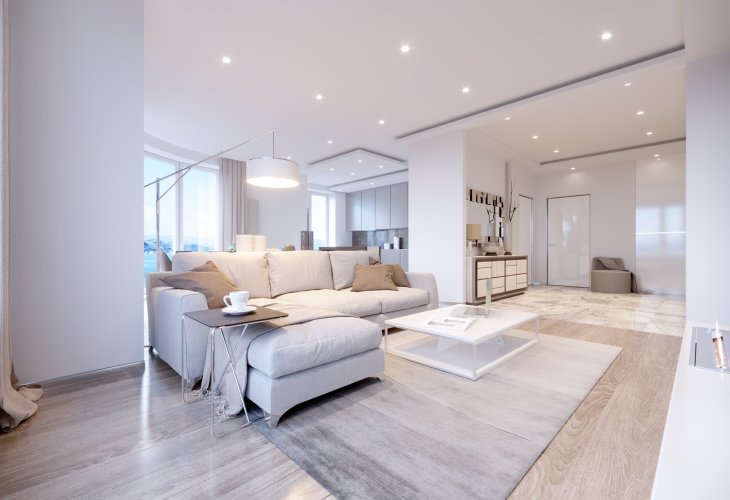Lighting Your Home: Choosing the Right Ambiance
Direct, indirect, diffused, or accent lighting—what works best, and how many types of lighting should you combine in one room?
 (Photo: shutterstock)
(Photo: shutterstock)Lighting isn't just for illumination anymore. It's what makes the difference between a well-designed room and one that truly captivates with a "wow" factor.
Consider a grand event hall located underground, yet so well-lit you forget there are no windows. Contrast that to an interrogation room with a lone bulb swinging above. See the difference? That's the power of lighting.
A detailed lighting plan is a crucial component of space design, deserving special attention. Importantly, lighting plays an essential role in the functionality of home rooms, serving both practical and functional daily purposes.
A welcoming, modern, and comfortable home appearance should be built on such a plan, which includes the right selection of lighting types, positioning, specifications, and effects.
To choose the right lighting for each space, first, get to know the existing types of lighting.
Lighting projects should always begin at the start of any construction or renovation work because they often require setting into walls and ceilings, and it's best to avoid this mess when everything else is finished.
Thus, the sooner you plan, the better. However, if this stage was missed during your project, know that you can still enhance lighting using readily installable elements like lamps and LED-strip lights. We will explain these in detail and present lighting solutions and ideas for every environment.
4 Types of Lighting and How to Choose
There are four broad types of lighting you can incorporate into your home. However, it's important to note that you don't need to use all options in a single space, as this can be detrimental.
The first step is defining the lighting needs of each room, according to the anticipated use of the space, since every family has unique requirements.
A good example is the living room. It's a multifunctional area in the home where residents meet for various activities such as hosting guests, reading, eating, and even working or studying. Different lighting may suit each of these activities.
Lighting methods you can use in your home:
Direct Lighting - As the name suggests, it illuminates directly on a specific spot or object. White light is preferred here as its intensity is high and concentrated.
Direct lighting is suitable in any environment where intense lighting is needed for tasks.
Lighting fixtures (ceiling or table), lamps, and chandeliers are the most common means of achieving this kind of lighting.
In the kitchen, for instance, you might use it over the countertop. In the dining room, direct lighting is perfect for the table and adds a special ambiance for meals.
In bedrooms, direct lighting is often in the form of adjustable wall fixtures used for reading.
In an office, direct lighting should focus on the desk.
In a bathroom, direct lighting can be installed near the mirror. It's particularly helpful for makeup application or shaving...
 (Photo: shutterstock)
(Photo: shutterstock)Indirect Lighting - Used to create points of light in spaces without the aim to illuminate them. This type of lighting is usually installed on the ceiling in the form of adjustable spotlights - perfect for creating an intimate and calming atmosphere.
Indirect lighting is excellent for use in public areas such as hotels, where the goal is relaxation. Thus, it is widely used in living rooms, dining areas, and bedrooms.
You can use indirect lighting, as mentioned, through adjustable spotlights or recessed fixtures in gypsum. Another alternative for indirect lighting is LED strips (a key advantage is they don’t require wall or ceiling embedding).
Tip: Ideally, the surfaces on which indirect light reflects should be white or transparent, allowing for light to spread evenly throughout the environment.
Diffused Lighting - This is the most popular and common type of lighting in homes. It is central lighting installed in the center of the ceiling.
Diffused lighting uniformly illuminates the room, without creating shadows or contrasts.
This type of lighting should be used throughout the home, from bedrooms to bathrooms, including living rooms and kitchens.
It can be in the form of flush mounts or pendants.
 (Photo: shutterstock)
(Photo: shutterstock)Accent Lighting - As you might imagine, the purpose of accent lighting is to highlight the design, including furniture, artwork, collections, or various textures and effects on a wall.
The best way to use accent lighting is through indirect light (spotlights, LED strips). The difference will be in the placement. For instance, place the spot within a niche to highlight it (widely used in stores).
Tip: Use about three different types of lighting for each space. Not only for different uses at different times, but sometimes they are used simultaneously. For example, a room may be designed with a combination of direct, diffused, and indirect lighting.
Tammy Rotenberg is an architect and interior designer. For questions and comments: office@tammyrotenberg.com

